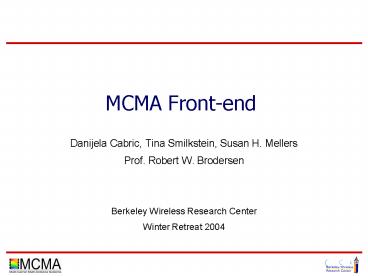MCMA Frontend
1 / 10
Title: MCMA Frontend
1
MCMA Front-end
- Danijela Cabric, Tina Smilkstein, Susan H.
Mellers - Prof. Robert W. Brodersen
- Berkeley Wireless Research Center
- Winter Retreat 2004
2
Introduction
- Benefits of multiple-antenna systems
- Increase in data rate
- Improvement of reliability against channel
fluctuations - Interference suppression and avoidance
- Goal of this project Prototype of a transmission
system - 1 Gbit/s data rate
- Spectrum efficiency of 40-50 bit/s/Hz (802.11a
4.8 bit/s/Hz) - Multiple antennas (MIMO), multiple carriers
(OFDM) - Parallel front-end with up to 16 antennas
- Testbed for different multiple-antenna algorithms
- Necessary prototype components
- Simulation framework for algorithm development
- Digital baseband processing design
- Prototype platform
- Parallel RF front-end
3
MCMA System Overview
- Fully parallel front-end with up to 16
transmit/receive antennas - Different MEA algorithms like Singular Value
Decomposition (SVD), Beam-forming
Fiber Optic Link
Parallel RF Front-End
Digital Baseband Processing on BEE Prototype
Platform
transp.
transp.
1
1
2
2
DataBits
Coding andModulation
N
M
Transmitter
Multiple-AntennaProcessing
Multiple-CarrierProcessing
Receiver
transp.
transp.
1
1
2
2
Demodulationand Decoding
DataBits
N
M
4
Testbed Specification
- BEE (Berkeley Emulation Engine)
- 600 GOP/s FPGA array previously developed at the
BWRC - To be used for data analysis and generation
- RF Front-end ?? BEE interface
- Thirty-two 1GHz fiber optical connections
- A/D and D/A
- 12-bit resolution for each of the sixteen DACs
and ADCs - Up to 64 MS/s sampling rate
- RF Front-end
- 20 MHz channel bandwidth
- 16 antennas
- Common local oscillator synthesizer
- Linear Power Amplifiers with output power 0 10
dBm - AGC with programmable gain of 0 36 dB
5
RF Front-end ?? BEE Interface
- Why we replaced the BEE SCSI interface with an
optical interface - Lower noise and good signal isolation
- Makes it possible to position RF front-end
farther from BEE when required - High transmission rate possible over optical
connection without shielding - Replaced SCSI connection with
- Xilinx Virtex II Pro
- Baseband data SERDES processing
- 1Gb/s serial rate
- Optical Transceivers
- Optical Riser Board
- BEE side SERDES processing
Optical Riser Cards
Peripheral Device
RF Front-end
Xilinx Chip
BEE
Optical Transceivers
6
Scalable RF Front-end
16
16
BEE
BEE
Fiber Optic Link
Fiber Optic Link
16
16
Up to 8 RF Modem Modules in each Chassis, for 16
antennas at each node. 2.40 2.485 GHz ISM Band
TDD. Optional FDMA in four sub-bands.
7
Single RF and Baseband Channel
RF Modem Module
JTAG
SBI TXON ANTSEL LNAGAIN
RSSI
PROM
AUX_ADC
ADC
Rx
LPF
Fiber Optic Xcvr Riser Card
Fiber Optic Xcvr
FPGA
BEE
DAC
LPF
Tx
SCSI Riser Card
AGC
AUX_DAC
SCSI
Ctrl
8
MCMA Baseband Modem and RF Transceiver Single RF
Modem Module
9
Local Oscillator and Digital Clock Distribution
14 RF Splitter
LNA
20 MHz VC-TCXO
Custom 2.4 GHz L.O. Distribution. Can be cascaded
for up to 16 L.O. outputs
National Synthesizer PCB used as 2.4 GHz Local
Oscillator
LVDS Dig-Clk from BEE
On-board Dig-Clk
MGT recovered clock
64 MHz LVDS Digital Clock Selection and
Distribution
10
Status Future Work
- MCMA Baseband board Designed, fabricated. Test
in progress. - RF Transceiver board (Intel) Three in house, 32
to be fabricated. - LO generation and distribution cards Top-level
design complete, schematics next. - Digital clock card and distribution
Specification complete, design to commence. - Power board In specification.
- Optical riser card Schematics complete, PCB
layout next. - Mechanical integration Modifying existing
cellular base station chassis. - Antenna array To be specified.































